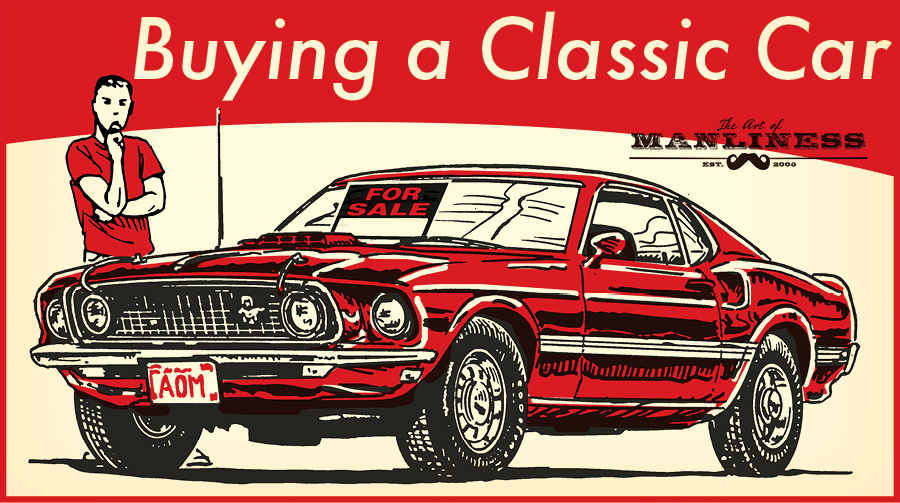Many men have the classic car bug hit them at some point in life. Maybe they want that car they dreamed about in high school (or actually drove, and still miss). For others, it’s the idea of taking a rundown classic and restoring it to mint condition. Some guys just like buying investment-grade cars with hopes of profiting off them in the future. No matter what your reasoning for wanting a vintage automobile, before you buy one on a whim, let’s dig into the reasons you might buy a vintage car, along with developing a plan for getting the best car for your budget and lifestyle.
Why Are You Buying a Vintage Auto?
As noted above, people buy vintage vehicles for all kinds of reasons, and being realistic about why you are buying a classic car is essential if you want it to be an enjoyable experience rather than one filled with rancor and regret.
The key is to buy for all the right reasons for you.
For example, you might want to get a 1965 Mustang convertible to go get milkshakes with the family. A rust-bucket/project car, assuming you have the time, money, and dedication to restore it, is going to take several years before it is roadworthy. By that time, your kids are in high school, and they have no interest in hitting the malt shop with Mom and Dad. In this case, a turnkey, ready-to-drive option may be the best bet for you.
If you’re someone with lots of spare time (and perhaps money as well) who enjoys fixing anything mechanical, a full restoration project might fit your profile.
If you want to buy a unique car in immaculate condition with strong investment potential, that car is going to be doing a lot of sitting without much tinkering or driving required. But as I’ll explain next, it’s important to understand that most classic cars don’t actually turn out to be a good investment.
Most Classic Cars Are Not an Investment
We’ve heard of the guy who doubled his money on a car sitting in his grandmother’s garage, but most attempts to flip a vintage vehicle for profit don’t turn out that way.
The truth is that these old cars are simply that: old cars. They have carrying costs: storage, maintenance, insurance, etc. Depending on the car, these costs can run hundreds to thousands of dollars per year.
And that’s not to mention restoration costs, of both money and time. That Mustang we referenced earlier might require $15,000 in work to get it in the condition you desire and it will still be worth about the same price you paid for it. A 1960s Corvette might cost $40,000, require $60,000 in restoration work, and now be worth $70,000-$90,000. Even if you do the repair work yourself, you might save tens of thousands of dollars in labor costs, but spend hundreds of hours in the garage away from your family. This begs the question: What is your time worth? If you like cranking a wrench on the nights and weekends, go for it. If you are thinking you will spend a couple hours a week working on a project car, you could lose interest long before its appreciated in value.
If your plan is to buy an investment-grade vehicle that you don’t plan to drive but will instead park in a temperature-controlled garage, waiting for demand to push the price up, do your research carefully on what car you buy. For example, many cars from the 1950s and 1960s have had no price appreciation for a decade. One theory is that the collectors, generally aged 60+, who used to desire these cars are either dying or downsizing their collections. Meanwhile, cars that were popular in the late 1970s to 1990s are experiencing price appreciation as the children of this era approach middle age with discretionary income to burn on collector cars.
Where to Buy Your Throwback Machine
Buying a classic car is not the same thing as buying a brand new Honda from the local dealer. You can’t just walk into a dealer, pick your comfort package, engine size, interior/exterior colors, and drive home that day with exactly what you want. To find the car you really desire, it’s going to take some work.
When buying a used car (emphasis added because racing stripes and polished wheels may make it seem new in your mind), constantly remind yourself of the phrase caveat peremptory “buyer beware.”
Buying at Auction
Classic car auctions are awesome . The crowd, the excitement, and the potential to get a deal on your dream machine all sound appealing. Here are some pros and cons for going this route:
Pros:
- Auctions do a great job bringing in high-end cars that may have never sat in a consignment dealer’s showroom. Some of the most desirable (i.e., expensive cars) have sold at auction rather than by private party or dealer.
- Auctions can often be accessed via phone or internet, giving you the opportunity to buy a car from the other side of the world.
- You can get a deal on a car with a no, or low, reserve. If only a few buyers bid on the car, you could walk out with a steal.

Comments
Post a Comment